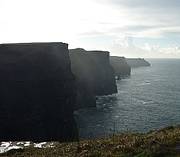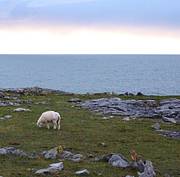Local to Global – the west of Ireland brought to Congress 2012
01 April 2012 | Article
Located at the western edge of Europe, Ireland is known as the Emerald Island thanks to its lush, green landscapes. Its wild countryside is only sparsely dotted with signs of habitation, though it is evident that a denser population worked the land in years gone by.
The country’s culture is unique, carrying with it centuries of hard labour and Celtic pride. But Ireland never recovered the loss of more than half its population in the 1850 famine. Today, depopulation is still a problem.
Brendan Dunford is Programme Manager at the Burren Farming for Conservation Programme, supported by the EU’s LIFE Nature Fund. The Burren, a region in the west of Ireland next to the Atlantic, offers some of the country’s most dramatic landscapes, including archaeological sites and natural wonders such as the Cliffs of Moher, a World Heritage Site.
For Brendan, the biggest threat to nature in this area is “rural depopulation, which is caused by social and economic factors. Communities are dying out, infrastructures such as schools and services are disappearing, and heritage values, which have evolved with people, are being diminished.”
So what action does he think IUCN should take to deal with this issue? “IUCN and others need to work to communicate and support the role of people in nature; very few ‘wild’ places are found in Europe – much of our wildlife depends on a certain level of human intervention. We need to see rural communities as a conservation resource that, with the right support, can make a huge difference to wildlife,” he says.
Every four years, the IUCN World Conservation Congress gathers global decision-makers and groups with local conservation interests under the same roof. The next event will be held in September and will address issues such as those brought up by Brendan Dunford. Dr Hans Friederich, Director of IUCN’s European Regional Office answers his questions:
• How can we make wildlife more relevant to the livelihoods of communities that inhabit our landscapes (e.g. Natura 2000 sites) and less of a burden (as is currently perceived)?
We need to reduce the nuisance factor and that means certain management measures may have to be introduced, regarding population levels, migration patterns, access to human settlements and the like. At the same time, the value of having certain wildlife species in the area can enhance the tourism potential for a site and may even attract media attention. The key is to turn wildlife from a negative factor in the landscape to a positive contribution to rural development.
• How can we best engage an increasingly urbanised society with nature?
I would start with the youth. Educational programmes for children in schools, in the press and on television are very important. Even more effective is to organize visits to natural areas, for school pupils to experience the outdoors, to hear the sounds of the forest, to feel nature and to enjoy being outside the city. It has been recognized that early, positive outdoor experiences for children have a profound effect on the way that in adulthood they treat nature and natural resources. The Bavarian Academy for Nature Conservation and Landscape Management in Laufen, Germany, has a fantastic programme “Tiere Live”).
Adults should also be encouraged to visit natural areas and to realize that there are animals and plants nearby. Nature is not only about elephants in Africa! For those who are reluctant, it may be important to create better access and make the experience easier and more rewarding by installing proper signage, information panels and maps to guide the visitors. In Switzerland, for example, this is very well done.
Journalists should be invited to film and write about outdoor experiences, and to interview park wardens, forest rangers and wildlife protection officers, so that people can read and hear about the interesting stories of their daily life.
• What role do you see biodiversity ‘credits’ or ‘offsets’ playing in the management of habitats and wildlife?
Offsetting the destruction of nature by the creation of an alternative natural area is a rather controversial notion, and IUCN does not promote this approach, unless there is no other option to deal with nature conservation. Avoiding damage to flora and fauna, reducing the effects of development and mitigating any negative impacts are more appropriate ways to dealing with changes in land use. Only if there are no other options, should we look at offsetting the damage by alternative means.
One of the most complicated aspects of this is to define the value of a certain area of nature, and to then translate this into a similar value for another area. How do you value a view from a steep cliff? What is the cost of destroying a culturally-significant forest grove? What is the proper replacement of a pond that is a pilgrimage site? These are questions for which there may be no clear answer, and economists will struggle to put a value on these intangible aspects of nature.
We know that our measurements of economic well-being do not take into account the offsets or credits on our environment. The cost of economic growth to nature will be right at the heart of the one of the World Leaders Dialogues, “Green growth: myth or reality?” during the IUCN Congress.





